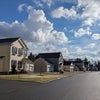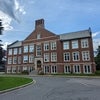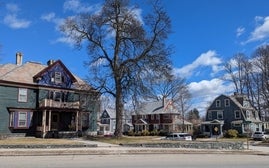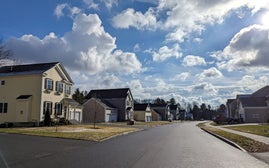Poverty up in Worcester neighborhoods, as home values lag
 Photo/Grant Welker
Storefronts on Main Street in Worcester's Main South neighborhood, where 43 percent of households live below the poverty line. Three times as many Worcester residents live in areas of concentrated poverty now than in 2000, according to a new report.
Photo/Grant Welker
Storefronts on Main Street in Worcester's Main South neighborhood, where 43 percent of households live below the poverty line. Three times as many Worcester residents live in areas of concentrated poverty now than in 2000, according to a new report.
Even with a long period of economic growth and redevelopment through significant stretches of downtown, Worcester has not been spared from some broader troublesome trends, according to a new report from the Boston think tank MassINC.
Worcester home values have fallen by 15 percent when adjusted for inflation since just before the Great Recession, placing it tied for last among the state's 26 Gateway Cities.
Concentrated poverty – neighborhoods where the poverty rate exceeds 40 percent – has tripled in Worcester since 2000, MassINC found. During that time, the number of Worcester residents living in Census tracts with those high poverty rates rose from 7,119 to 22,770.
Vacant homes are on the rise in the city. In 2000, 5 percent of Worcester homes were vacant, but that rate rose to 9 percent by 2017.
Those trends are the result of a range of factors, according to MassINC, including fewer funds being spent on neighborhood improvements from state or federal agencies and less discretionary state aid for cities and towns.
"When you already having broader economic inequality, and you lose the tools to counter that trend, it's kind of a perfect storm, and it feeds on itself," said Ben Forman, MassINC's research director.
More specifically to Worcester, the data shows housing has not risen along with the economy or perhaps been carried by Greater Boston's surging housing market. Worcester’s decrease in housing value since 2006 places it – along with Fitchburg and Fall River – last among Massachusetts Gateway Cities.
Those statistics could raise questions about how well Worcester is attracting the type of new residents municipal leaders often aim for: professional workers with disposable income to spend on restaurants and shops.
Worcester’s highest-profile new housing development, 145 Front at City Square in downtown, still has a high vacancy rate.
According to 145 Front's website, at least 158 of its 368 units remain unoccupied, for a 43-percent vacancy rate as of last week. The development, where apartments start at $1,525 a month for a studio, opened for its first tenants in February, with a smaller second phase opening months later. An advertised deal offers up to two months of free rent on leases of 15 to 18 months.
Other housing developments are in the pipeline.
Developers will look to fill 55 new mixed-income apartments at the Central Building on Main Street, which are currently under construction, and more than 100 apartments at the former Worcester County Courthouse in Lincoln Square, for which construction is slated to start in the spring. In the Canal District, 48 units are under construction at Harding Green, and a mixed-use development to be built next to a new stadium for the Pawtucket Red Sox is envisioned for 225 market-rate apartments.
Today, those neighborhoods are suffering from economic hardship, with 38 percent of households downtown living below the poverty line, and 35 percent in the Canal District.
In the meantime, median rents in Worcester – still among the lowest in Central or Eastern Massachusetts cities – have been on the rise, climbing nearly 16 percent in the past year to $1,330, according to the real estate website Zumper.
As for single-family homes, the median sale price in Worcester was $236,250 for the year through last October, according to The Warren Group. That rate was up 5 percent over the previous year.
MassINC studied per-square-foot values of homes in each Gateway City. Worcester’s rate of $166 per square foot landed it 19th out of 26 Gateway Cities. Fitchburg’s rate was $144, landing it fourth from worst.
MassINC’s report found a rising number of vacant homes in Gateway Cities, including Worcester, Fitchburg and Leominster. Those vacancy rates – 9 percent in Worcester, 11 percent in Fitchburg and 6 percent in Leominster are all higher than in 2000 – don’t indicate a lack of demand so much as a lingering effect of foreclosures taking time to hit the market again, Forman said.
"You get these issues in older cities that are complicated to sort out,” he said.
The latest data from MassINC, which focuses much of its research on Gateway Cities, adds to Census data released last fall showing declining median income in Worcester.
The median income for a Worcester household fell by 5.6 percent in 2017 to $41,561. Rates of top-earning households fell, and those of the lowest-income households rose.
What isn't clear is whether lower income rates are the result of people earning less or whether lower-earning workers are moving into Worcester, perhaps from more expensive neighborhoods in or around Boston.
"It's probably a mix," Forman said. "It's really hard to say."












0 Comments